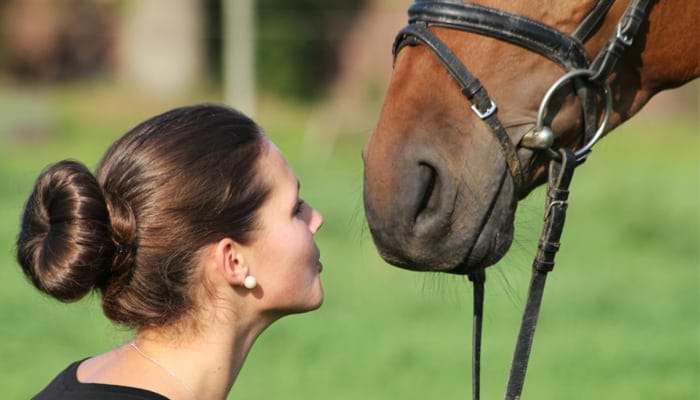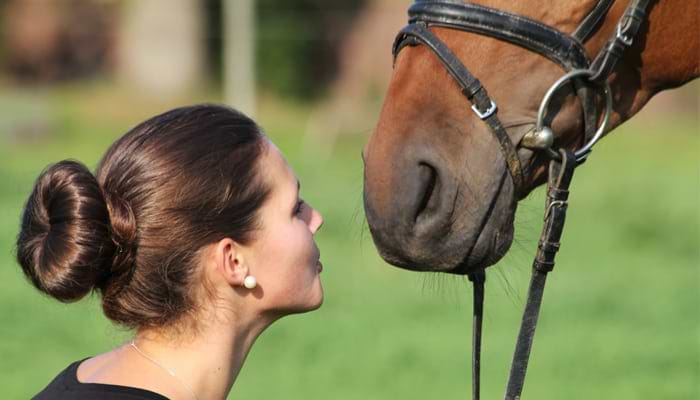
Horse whispering is a method of training horses that dates from the early 19th century. Especially beneficial for horses who are traumatised, or particularly wild, it involves "speaking" to the horse and being intuitive enough to understand his needs and behaviour.
These skills are not something that a beginner can master overnight. It can take many years of observing and interacting with a horse before you can grasp the art of horse whispering. While the technique is around 200 years old, it was incorporated into a package of training methods known as "natural horsemanship" in the 1980s.
The basics of horse whispering include training with calmness and kindness rather than domination, using the appropriate body language when you give commands, observing your horse and "listening" to him by learning to interpret his behaviour.

© fotospirale / Adobe Stock
Horse whispering origins
The practice of horse whispering was founded by the appropriately-named Irish horse trainer, Daniel "Horse Whisperer" Sullivan, who was born in the 18th century in Mallow, County Cork. Sullivan came up with the idea after working with horses who had been the subject of trauma and extreme abuse.
In those days, traditional horse training techniques left much to be desired. They were aimed at dominating the horse by fear, using aggressive and cruel means such as whipping, blindfolding and otherwise restraining the horse.
Sullivan began rehabilitating mistreated horses but was secretive about his methods. People who watched him at work noted that he frequently stood very close to the horse and appeared to be whispering. He would stand face-to-face with the horse, speaking to it in a way that it seemed to understand.
Even severely traumatised horses would quickly become gentle as a result of his mysterious technique, which came to light in the early 19th century. It was said that his method grew from tips he had learned from a member of the travelling community, but beyond that, little was known about his own life.
John Solomon Rarey
After Sullivan's death in 1810, horse whispering might have died with him, but for the determination of a few horse trainers to keep it alive. His fame spread to the United States, where one horse trainer who used his techniques was John Solomon Rarey, of Groveport, Ohio.
He began training horses from the age of 12 and became so famous that Queen Victoria summoned him to Windsor Castle in 1858 to calm one of her horses. It was reported that as soon as Rarey touched the horse, it began to relax and laid on the ground. Rarey laid down too, resting his head on the horse.
Queen Victoria was amazed and delighted. She paid him £100 for his services and he became well-known in England, thanks to interest from the press. He was asked to try his horse whispering on a horse labelled the "most ferocious in all England".
Cruiser had been kept in a stable and used solely for breeding. Rarey shut himself in the stable with Cruiser. After three hours, he emerged, leading the horse without a muzzle. Cruiser was "gentle as a lamb", according to an eye witness report.
The owners were so happy that they gave Cruiser to Rarey, who took him back to the United States. The horse lived in Ohio with his trainer, who would take him to public demonstrations of horse whispering.
Sadly, Rarey died in 1866, but he loved Cruiser so much that he left provision in his will for the horse's care. Cruiser lived at Rarey's home in Ohio until his own death in July 1875.
Willis J Powell
Horse trainer and author Willis J Powell wrote a famous book about horse whispering, called Tachyhippodamia: The New Secret of Taming Horses, which was published in the mid-1800s. He wrote about Sullivan, calling him the "Irish horse whisperer".
Powell said horses resisted humans only because of fear, so to tame a horse, those fears must be calmed. He revealed how a "soothing touch" could communicate calm and safety. Then, it became easier to help the horse get used to things that might previously have caused alarm.
Modern horse whispering
The traditions of these 19th-century trainers were spread by their writings, or by other horse whisperers who had learned directly from them. While Sullivan had largely kept his methods secret, Rarey realised the importance of revealing the technique to the world, rather than risk it being lost forever.
The method was faithfully represented in the novel by Nicholas Evans, The Horse Whisperer, in 1995. It was turned into a successful film of the same name, starring Robert Redford in the title role, in 1998. The plot revolved around a horse whisperer employed to help an injured teenager and her horse regain health following an accident.
Today, numerous trainers are known as horse whisperers, building on the work of the early pioneers of the technique. The methods haven't changed a great deal since the 19th century - the most important thing is understanding the horse and its body language.
Natural horsemanship
In the mid-1980s, horse whispering began to rapidly gain popularity. It became incorporated into a body of training techniques known as "natural horsemanship". This was attributed to a book by American horse trainer Pat Parelli, who first coined the phrase.
Monty Roberts
One of the most famous modern horse whisperers is Monty Roberts, who popularised the technique in his book, The Man Who Listens to Horses, in 1996. Now aged 84, California-born Roberts has gone a step further. He believes horses use their own non-verbal language, known as "Equus", which humans must learn in order to communicate with them.
He runs his Equestrian Academy in Solvang to promote his ideas, which he has learned and developed after a lifetime with horses. Born in 1935, the son of a horse trainer, he competed in rodeos from the age of four, when he won his first trophy.
He wrote about how horses used a discernible body language to communicate. It could show fear, affection, annoyance, and relaxation. Roberts realised that utilising this silent language enabled him to train horses in a more humane and effective manner, leading to a true partnership with his animal.
For the love of horses
Griggs Equestrian supplies an affordable range of branded equine products, including high-quality equestrian clothing and accessories. Contact us for further details.





